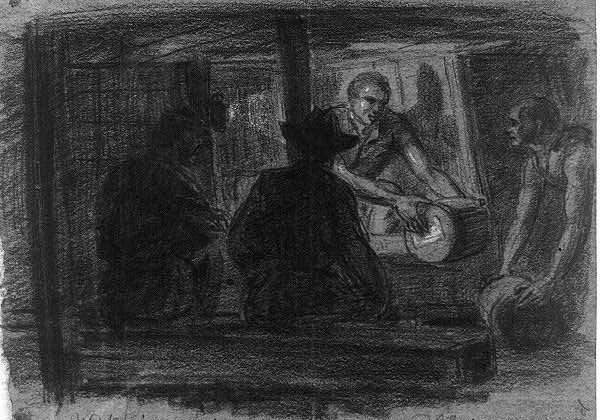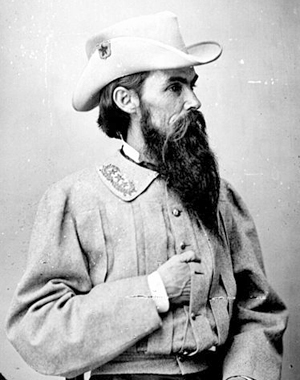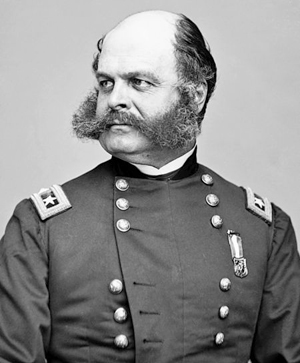The Crater • Tour the Battlefield • Battle Maps • The Armies • Petersburg Timeline
The Battle of the Crater took place outside Petersburg, Virginia on July 30, 1864. In the early morning a massive explosion blew an entire redoubt of the Confederate defensive works southeast of town high into the air. It killed 278 men and left a crater that can still be seen today. Grant hoped it would be the key that would open the way to Petersburg and Richmond. But in the end it was, in his own words, “The saddest affair I have witnessed in this war.”

Men of the 48th Pennsylvania fill the mine with powder.
The digging of the mine at The Crater and its explosion were as successful as anyone could hope. But the attack which followed was filled with every kind of poor leadership found in the Army of the Potomac: blind interference by high command, bad planning, incompetence, drunkenness and sheer cowardice. Combined with a swift and bold Confederate counterattack, the result was a Federal massacre. Grant would launch no more direct assaults at Petersburg for eight months.
On this site
Tour the Crater and the mine entrance, preserved by the National Park Service as part of the Eastern Front of the Petersburg National Battlefield.
See a series of situation maps that show and explain the day’s fighting.
See the order of battle of the units involved.
Battle of the Crater Facts
What was the Battle of the Crater?
The Battle of The Crater was an attack on Confederate defensive lines southeast of Petersburg, Virginia. It started with the explosion of a massive mine under a Confederate redoubt that blew a huge crater into their defensive lines.
Who fought in the Battle of the Crater?
About 13,000 Union troops under the local command of Major General Ambrose Burnside.
About 6,100 Confederate troops under the command of Brigadier Generals Bushrod Johnston and William Mahone. Johnson commanded the defending troops – apparently from his headquarters in the rear – while Mahone brough up his division from reserve and spearheaded the counterattack that recaptured the Crater.
Other troops from both armies were in position nearby and supported the fighting.
 Confederate Major General William Mahoney |
 Union Major General Ambrose Burnside |
When was the Battle of the Crater?
The mine exploded at 4:44 in the morning of July 30, 1864. The fighting lasted until about 2:30 in the afternoon.
Where was the Battle of the Crater?
The Battle of the Crater was on the southeast side of the Confederate defenses around Petersburg Virginia. It is currently part of the Petersburg National Battlefield Park’s Eastern Front.
Who won the Battle of the Crater?
The Confederacy. It was a major Union debacle that Ulysses S. Grant called, “the saddest affair I have witnessed in this war.”
How many casualties were there in the Battle of the Crater?
The South lost about 1,500 men. The North lost about 3,800 men, of whom 1,400 were captured. Very few of the captured were from the African-American troops that made up a fourth of Burnside’s men, as most Confederates refused to accept their surrender.
What was the importance of the Battle of the Crater?
Grant recognized that the Battle of the Crater was the best opportunity he would have to carry the Confederate defensive works around Petersburg. Had the assault succeeded the Union attackers would have seized a strategic hill overlooking the city of Petersburg and its bridges over the Appomattox. Confederate forces would probably have had to evacuate the city. Richmond, dependent on the supply link through Petersburg, would have probably fallen as well.
What was the result of the Battle of the Crater?
The failure of the Union attack in the Battle of the Crater led to eight more months of siege warfare around Petersburg. Unitl the very end of the siege Grant refused to launch another direct assault on the Confederate defensive lines, instead repeatedly trying to outflank the Confederate defences.
General Burnside and one of his division commanders were relieved in disgrace, although Meade, who should have shared the blame with Burnside for interfering with the plans at the last minute, escaped immediate censure. On the Confederate side the reputation of William Mahone soared. He was promoted to Major General and confirmed in command of his division.
Facts about the mine
Main shaft length: 510 feet
Powder galleries length: 75 feet
Height: 5 feet
Width: four feet at bottom, two feet at top
Amount of earth moved: 18,000 cubic feet
Facts about the Explosion
Amount of gunpowder used: 8,000 pounds
Size of crater: 170 feet wide, 50 feet across and 30 feet deep at deepest point
Men killed by the explosion: 278
